5 Best Rotary Laser Levels in 2020
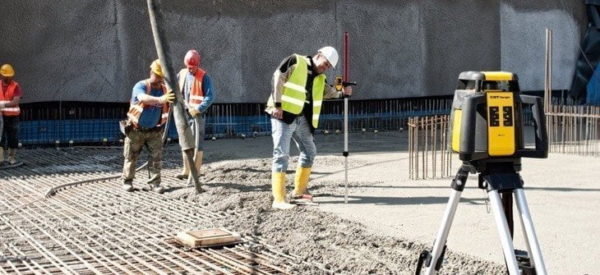
Making the perfect level line on the job can be a time-consuming task. This is especially true if the level line needs to be hundreds of feet across. One tool that solves this problem is the rotary laser level. It is a 2-part system that consists of a laser transmitter and a receiver.
>> Click Here to Skip the Review and See Our Favorite Laser Level
In a nutshell, it projects a laser line 360-degree away from the transmitter. To complement it, the receiver captures the laser beam and tells the user with an audible tone or LCD readout where the level line is from the ground. This is a useful companion for any type of professional leveling projects and suited for everyone with any experience as it is very easy to set up and use.
Image | Product Name | Range | Rotation Speed | Accuracy | Rating | Current Price |
|---|---|---|---|---|---|---|
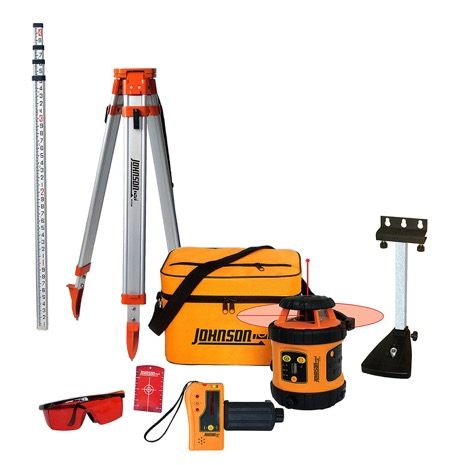 | 1. Johnson-Level-Tool-99-006K Rotary Laser Level | 200 ft | 200; 400; 600 RPM | + / - 1/8 in @ 50 ft | 4.5 | |
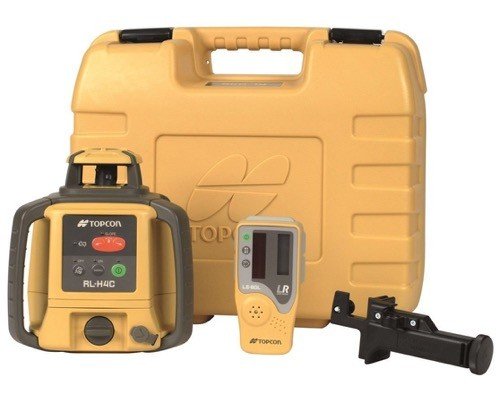 | 2. Topcon RL-H4C Rotary Laser Level | 2600 ft | 600 RPM | + / - 1/16 in @ 100 ft | 4.7 | |
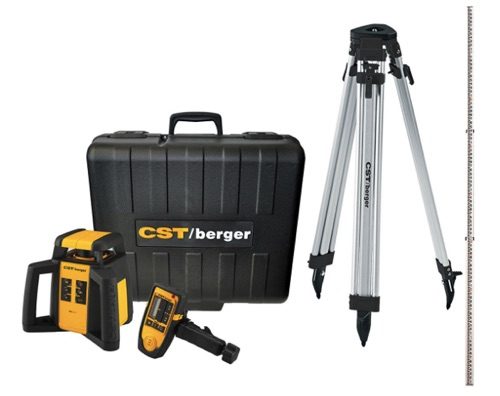 | 3. CST/berger RL25HCK Self-Leveling Rotary Laser Kit | 2000 ft | 150; 300; 600 RPM | + / - 3/32 in @ 100 ft | 4.7 | |
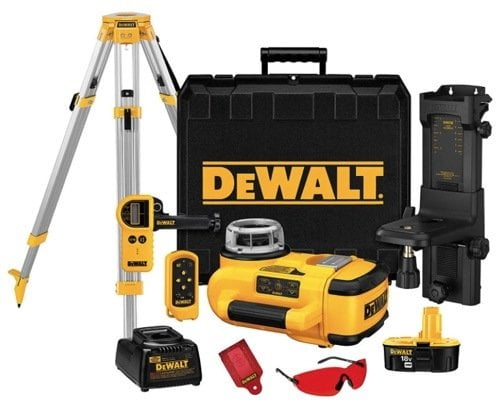 | 4. DeWalt DW079KDT Self-Leveling Rotary Laser Kit | 2000 ft | 60; 250; 600 RPM | + / - 1/8 in @ 100 ft | 4.6 | |
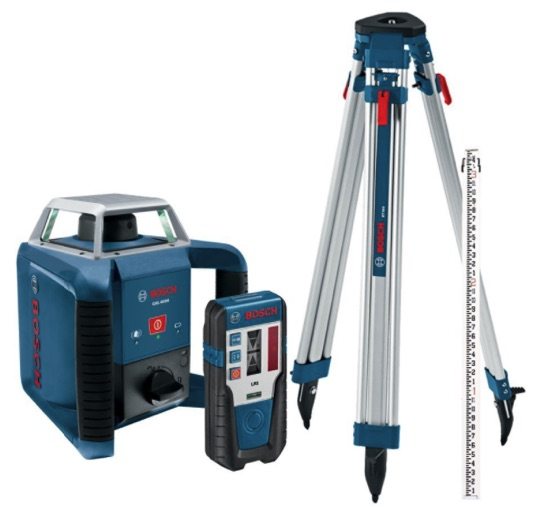 | 5. Bosch GRL400HCK Self-Leveling Rotary Laser Kit | 1300 ft | 350; 600; 1200 RPM | + / - 3/32 in @ 100 ft | 4.0 |
5 Best Rotary Lasers - Reviews
#1. Johnson-Level-Tool-99-006K Rotary Laser Level
Editor's Rating:  (4.5 / 5)
(4.5 / 5)
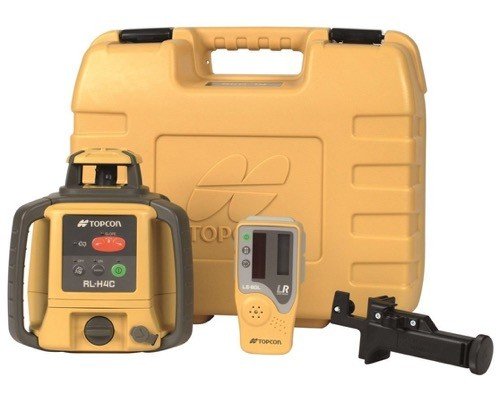
The Johnson-Level-Tool-99-006K is one of the best laser level currently on the market. It is used by many professionals who need a quick and accurate level line. This unit has an automatic horizontal leveling system that projects a bright 5mW 360-degree laser to indicate a plumb line as well as sends an audible signal to the receiver.
Additionally, there is a basic LCD screen that indicated the level line with an up or down arrow. It is basic, but still enough to help the user quickly and easily set up a straight line over 100 feet.
This unit is delivered as a complete kit, with a measuring tape as well as a stand. The receiver can easily be locked in position to the tape measure while the transmitter base locks securely to the stand.
Unfortunately, when it comes to slopes, this model is not the best rotary laser level for the money as it works only on a horizontal plane. However, accuracy is still good and the 3 rotational speeds of 200, 400, and 600 RPM are easy to set based on the laser brightness needed.
Pros
- Cost-effective. Value for money
- Receiver can be wall or ceiling mounted with provided clamp
- Works with common AA alkaline batteries
- Easy to set a 90-degree angle
- 3 rotational speeds for either visibility or long-distance work
Cons
- Not the loudest audible sound
Who Should Buy?
The Johnson-Level-Tool-99-006K is almost a limit to what can be considered a professional rotary laser level. It does not have the best features we have seen, but it has by far one of the best prices.
Also, the 90-degree split beam and the bright laser is mostly useful when used indoors. Therefore, we recommend it for those who need to work indoors for not more than 100 feet from the transmitter to the receiver.
[su_asin asin="B00ME77KCI"]
#2. Topcon RL-H4C Rotary Laser Level
Editor's Rating:  (4.7 / 5)
(4.7 / 5)
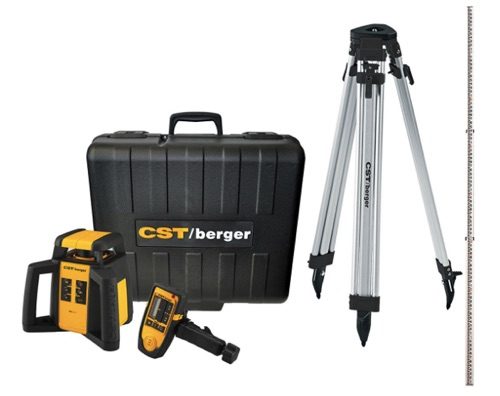
This is an interesting offering from Topcon. The RL-H4C is built like a tank and is also somewhat weather resistance. In addition, it is one of the best rotary laser levels when it comes to distance.
Indeed, this unit can work without any problem up to 2,600 feet. More interestingly, it does well with slopes of up to 5-degree with an excellent accuracy of 1/16 inch when used for less than 100 feet.
The battery life is also excellent, with up to 80 hours of continuous use. To help the user save on battery like during idle times, the device will automatically switch off after 30 minutes. Indeed, it seems that the Topcon RL-H4C does everything to help the user use it in the most efficient manner possible.
The only caveat is the 2.4 mW laser, which is not the brightest. However, it is still more than enough laser light for most people.
Pros
- Solid build construction. Partially weather-proof
- Automatic shut off after 30 minutes of idle time
- Works with slopes of up to 5-degrees
- Buttons are weatherproofed
- Level line can easily be locked in position with a knob
Cons
- 2.4 mW laser line. Can have difficulty seeing during a bright sunny day
Who Should Buy?
We can safely recommend the Topcon RL-H4C as a long-distance and outdoor unit. It is one of the best rotary lasers on the market right now and works well even when used for 800 m (2,600 feet).
[su_asin asin="B07B8YW75P"]
#3. CST/berger RL25HCK Self-Leveling Rotary Laser Kit
Editor's Rating:  (4.7 / 5)
(4.7 / 5)

The emphasis of the CST/Berger RL25HCK is its build quality. It is made to withstand the daily trials of a busy workplace and it is long-lasting and durable. There is a thick over-mold layer on sensitive parts for this effect.
Moreover, it is delivered as a complete kit with a tape measure and a tape, along with a carry case and receiver. The transmitter has 2 large handles for portability and clearly, it is a device made to be carried around a lot.
One of its main problems is the low laser power of 1 mW, that may be difficult to spot from a distance. Additionally, the accuracy of 3/32” is not the most accurate we have seen in a rotary laser level at this price point.
However, it is still a decent model that works great for up to 2,000 feet and the receiver audible quality, as well as LCD readability, is excellent. It even has a slope adjustment and the ADS system makes it easy to tell when the laser has moved from position.
Pros
- Rugged design. Durable and long-lasting build quality
- Long working distance of 2,000 feet
- ADS system. Easily get a notification when the laser line moves
- Can be adjusted to compensate for slopes
- 2 handles for ease of adjustment over the tripod
- Works with common D-cell Alkaline batteries. Easily available
Cons
- Not the best leveling accuracy of 3/32 inch
Who Should Buy?
This unit will make an excellent companion for those who work on a busy and slanted worksite with the possibility of the laser tool falling. It is built like a tank and will withstand even the most severe fall. It is also an excellent tool that is highly rated by many rotary laser level reviews, mostly for its durability and reliability.
[su_asin asin="B008OQHMIK"]
#4. DeWalt DW079KDT Self-Leveling Rotary Laser Kit
Editor's Rating:  (4.6 / 5)
(4.6 / 5)
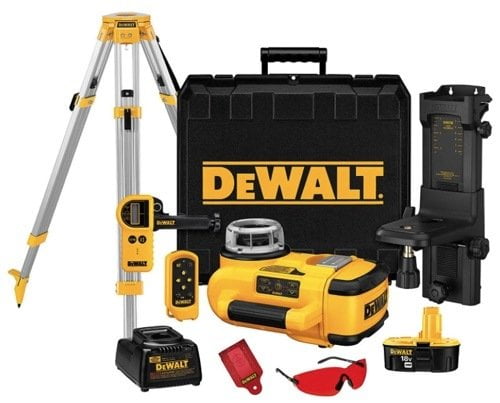
The DeWalt DW079KDT is a top of the line rotary laser level. It can automatically adjust the level line both horizontally and vertically. This makes it an excellent rotary laser level for both indoor and outdoor use.
It has a solid build quality and a decent range of 2,000 feet outdoors. Not the longest working range we have seen in a laser level though. The transmitter is weatherproof and protected making it able to work outside on a cloudy or even partially rainy day.
When used indoors, a bright laser beam gives a straight plumb line of up to 100 feet. Furthermore, the sloping mode allows the user to adjust the transmitter on the fly up to 5-degrees.
A major caveat with this unit is its accuracy. It has a 100 feet accuracy of only 1/8”, which while enough for most outdoors purposes, may not be enough for those looking for extreme accuracy indoors. However, it makes up for with a 3-speed rotation control when a laser beam visibility of up to 200 feet.
Pros
- Long laser line visibility of up to 2,000 feet
- Excellent build construction. Transmitter is weather-proof
- Sloping angle adjustment up to 5-degrees
- Delivered as a complete kit, including a plastic carry case
- Weatherproof for both indoors and outdoors use
Cons
- 1,500 working range. Not the longest
- Accuracy is only 1/8 inch
Who Should Buy?
Despite a few problems here and there, the DeWalt DW079KDT is still a professional rotary laser level that has a lot to offer. We recommend it as both an indoor and outdoor unit where reliability and ease of use are more important than working distance.
[su_asin asin="B001CC8TLW"]
#5. Bosch GRL400HCK Self-Leveling Rotary Laser Kit
Editor's Rating:  (4 / 5)
(4 / 5)
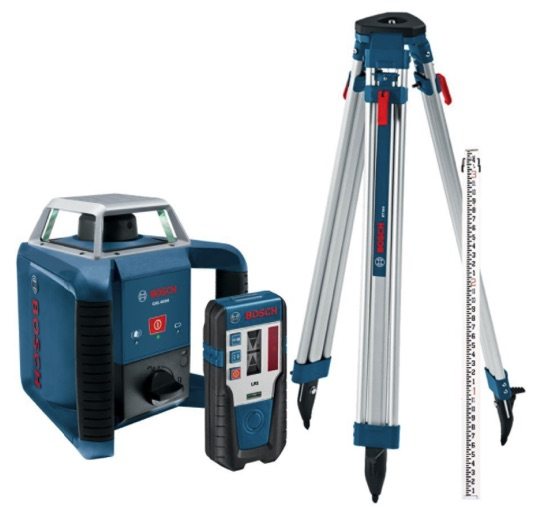
The Bosch GRL400HCK is another complete rotary laser level kit that packs a punch. It has an automatic horizontal leveling, that is quite fast to lock on the laser line due to its dual laser system. We find that the 2-handles on the transmitter make it easy to carry or position over the provided aluminum stand, and it automatically detects when the laser line is out of level. A clean audible sound can be heard on the receiver, and the LCD panel has indications for up and down for a much easier alignment.
Furthermore, the beam strength can be customized along with the 3-speed rotation of 350, 600, and 1,200 RPM that allows the user to match the work light condition.
The best feature in this model remains the microfine plumb alignment, where the user can find the plumb line from the receiver without ever moving the transmitter. This can prove handy where the laser level transmitter must be set in a fixed position.
The only drawback we can find with this unit is its relatively weak laser power output of 1 mW, which is not the most visible in bright conditions.
Pros
- Value for money
- Clear LCD readout at the back of receiver
- Microfine plumb line without moving the stand
- 3 rotation speed of 350, 600, and 1,200 RPM and 6 beam customizations for versatility
- Automatic out of line alerts
Cons
- Does not work with slopes
- Weak 1mW laser output
Who Should Buy?
If you are only looking for a horizontal level line of no more than 1,300 feet, this model from Bosch has a lot to deliver. It is not the best self-leveling rotary laser on the market, but it delivers enough versatility, value for money, and ease of use to be close to it.
[su_asin asin="B07NWBPTT7"]
Things to Consider When Buying Rotary Laser Kit
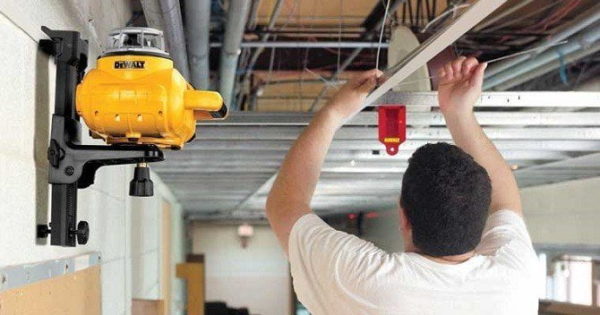
#1. Stand Height
For people working on rough terrains with small hills, it is best to get a rotary laser level with a long stand. This way the transmitter can be set to transmit over a hill if need be. Additionally, the stand must be stable and offer ease of height adjustment. Most stands for this device is usually made from an aluminum alloy that is both lightweight and durable.
#2. Slope and Angles
A transmitter than can compensate for ground slopes is very helpful when used outdoors, given that a natural terrain has subtle up and down curves. Most quality models can compensate for up to a 5-degree slope. Additionally, 90-degree angles can prove handy when used indoors and it projects both a horizontal and vertical laser beams on the wall. Carefully check your model for 90-degree angles as not all rotary laser levels offer a vertical laser beam.
#3. Audible Sound and LCD Screen
For the best user experience, a unit that comes with both an audible tone and an LCD indicator is preferred. Some people are easily annoyed with the sound of a rotary laser level.
Basically, the receiver constantly beeps until the level line is reached. The closer to the level line, the louder and more frequently it will beep. A receiver with an LCD will indicate via an Up or Down arrow if the level line is close or far.
#4. Laser Class
In many countries and some states in the USA, a laser class above 5 mW is not allowed. Enquire about your allowed laser class limit and ensure that your device transmits a laser below that threshold.
#5. Laser Rotation
The faster the laser rotation in the transmitter, the faster the receiver can tell when the plumb line is reached. Alternatively, a lower rotation generates a brighter laser line while a faster speed is usually for long-distance and outdoor use. We recommend a minimum of 600 RPM for the laser rotation. A unit with a variable laser rotation will be a superior product.
#6. Range
The transmitter must be able to project a laser to your maximum working distance. The minimum working range of a quality rotary level should be at least 1,300 feet outdoors and 100 feet indoors.
#7. Tape Measure
The tape measure is the traditional way of knowing the exact distance of the level line from the ground. Most people will find it useful to know and is a nice addition to the laser level.
#8. Locking Mechanism
Once you get your level line, you will want to lock it in position on the tape measure. The locking mechanism is generally found on the receiver end of the device, either directly fitted or via a locking adapter. Make sure it has an easy and secure locking mechanism as you may wish to check the level line in another location with the same measurement.
Last Updated on January 26, 2020 by
